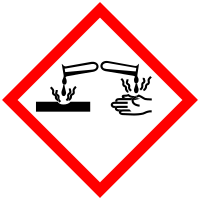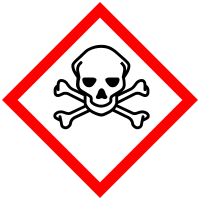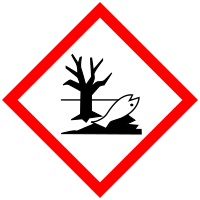
Improving Member States preparedness to face an HNS pollution of the Marine System (HNS-MS)
Chloroacetic Acid Solutions
Description Top
| CAS number | 79-11-8 |
| UN number | 3250 |
| Chemical formula | C2H3ClO2 |
| Standard European Behaviour Classification (SEBC) | Dissolves (D) |
| Abilities | Solution. |
GESAMP Hazard profile
| A1 | A2 | B1 | B2 | C1 | C2 | C3 | D1 | D2 | D3 | E1 | E2 | E3 |
| 0 | R | 2 | 0 | 2 | 3 | 4 | 3C | 3 | A | NI | D | 3 |
Marine pollution Classification (MARPOL Annex II)
| Category | Description |
| Y | Noxious Liquid Substances which, if discharged into the sea from tank cleaning or deballasting operations, are deemed to present a hazard to either marine resources or human health or cause harm to amenities or other legitimate uses of the sea and therefore justify a limitation on the quality and quantity of the discharge into the marine environment. |
Alternate names for this chemical
Monochloroacetic Acid
Chloroacetic Acid Solutions
Solutions D'Acide Chloroacetique
Chloroacetic Acid Solutions
Solutions D'Acide Chloroacetique
Physico-chemical properties Top
| Chemical formula | C2H3ClO2 | |
| State | Liquid at 25°C and 1 atm | |
| Hydrosolubility |
|
Behaviour Top
| Standard European Behaviour Classification (SEBC) | Dissolves (D) |
Hazards Top



Danger
Hazards statements
Physical
H290
May be corrosive to metals.
Health
H301
Toxic if swallowed.
H311
Toxic in contact with skin.
H314
Causes severe skin burns and eye damage.
H331
Toxic if inhaled.
H335
May cause respiratory irritation.
Environmental
H410
Very toxic to aquatic life with long lasting effects.
Precautionary statements
Prevention
P234
Keep only in original container.
P260
Do not breathe dust/fume/gas/mist/vapours/spray.
P273
Avoid release to the environment.
P280
Wear protective gloves/protective clothing/eye protection/face protection.
Response
P390
Absorb spillage to prevent material damage.
P301 + P330 + P331
IF SWALLOWED: rinse mouth. Do NOT induce vomiting.
P302 + P352
IF ON SKIN: Wash with plenty of soap and water.
P305 + P351 + P338
IF IN EYES: Rinse cautiously with water for several minutes. Remove contact lenses, if present and easy to do. Continue rinsing.
P309 + P311
IF exposed or if you feel unwell: Call a POISON CENTER or doctor/physician.
Storage
P406
Store in corrosive resistant/... container with a resistant inner liner.
Disposal
P501
Dispose of contents/container to ...
GESAMP Top
GESAMP Hazard profile
| A1 | A2 | B1 | B2 | C1 | C2 | C3 | D1 | D2 | D3 | E1 | E2 | E3 |
| 0 | R | 2 | 0 | 2 | 3 | 4 | 3C | 3 | A | NI | D | 3 |
A1: Bioaccumulation
| Rating | Description |
| 0 | No potential to bioaccumulate |
A1a:
| Rating | Description | Criteria [mg/l] |
| 0 | No potential to bioaccumulate | Log Kow < 1 |
A1b:
| Rating | Description |
| NI | No Information |
A2: Biodegradation
| Rating | Description |
| R | Readily biodegradable |
B1: Acute aquatic toxicity
| Rating | Description | Criteria [mg/l] |
| 2 | Slightly toxic | 10 < LC/EC/IC50 ≤ 100 |
B2: Chronic aquatic toxicity
| Rating | Description | Criteria [mg/l] |
| 0 | Negligible | NOEC > 1 |
C1: Acute oral toxicity
| Rating | Description | Criteria [mg/Kg] |
| 2 | Moderate | 50 < AOTE ≤ 300 |
C2: Acute dermal toxicity (skin contact)
| Rating | Description | Criteria [mg/Kg] |
| 3 | Moderately high | 50 < ADTE ≤ 200 |
C3: Acute inhalation toxicity
| Rating | Description | Criteria [mg/l] (4 hours exposure) |
| 4 | High | AITE ≤ 0.5 |
D1: Skin irritation or corrosion
| Rating | Description | Sign | GHS category |
| 3C | Corrosive | Full-thickness skin ne | Corrosive Category 1A |
D2: Eye irritation
| Rating | Description | Sign | GHS category |
| 3 | Severely irritating or corrosive | Severe conjunctoblepha | Irritant Category 1 |
D3: Long-term health effects
| Notation | Hazard endpoint | Description | GHS category |
| A | Aspiration | Lung injury or chemical pneumonia following aspiration of a chemical through the oral or nasal cavity into the trachea or lower respiratory system | Category 1 for Aspiration Toxicity |
E1: Tainting of seafood
| Rating | Description |
| NI | No Information |
E2: Behaviour of chemicals in the marine environment
| Rating | Description |
| D | Dissolves |
E3: Interference with the use of coastal amenities
| Rating | Interference | Description | Interpretation | Warning |
| 3 | Highly objectionable | 1 is highly acutely toxic; and/or 2 is severely irritant or corrosive to skin or eyes; and/or 3 is carcinogenic, mutagenic or reprotoxic; and/or 4 is a floater or persistent floater with associated health effects | 1 C1 and/or C2 and/or C3 = 4; and/or 2 D1 or D2 = 3, 3A, 3B, or 3C; and/or 3 D3 contains C, M or R; and/or 4 E2 = F or Fp and D3 contains Ss, Sr, T, A, N, or I | Warning issued leading to the closure of amenities |
GHS Security Information



Danger
About the project
HNS-MS is a decision-support tool that Belgian and French maritime authorities as well as coastguard stations can activate in order to forecast the drift, fate and behavior of acute marine pollution by Harmful Noxious Substances (HNS) accidentally released in the marine system.
Contact us
Copyright © 2015–2025 HNS-MS Consortium
 HNS-MS has been funded by DG-ECHO under agreement ECHO/SUB/2014/693705 and runs from 1 January 2015 to 31 March 2017.
HNS-MS has been funded by DG-ECHO under agreement ECHO/SUB/2014/693705 and runs from 1 January 2015 to 31 March 2017.